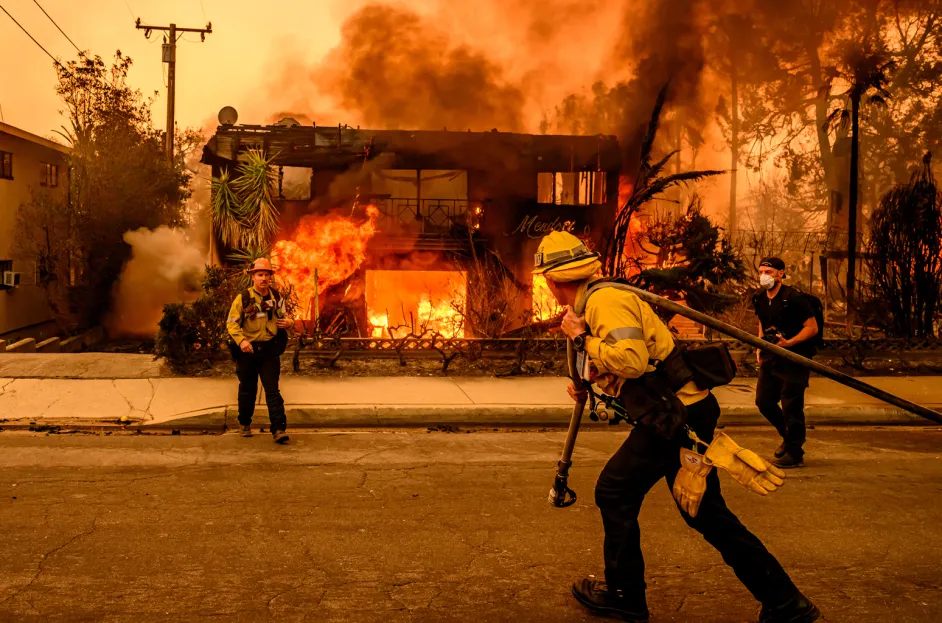The Inferno That Shook America

Built to Burn: How America’s Most Disaster-Ready City Flunked the Test

Peerzada Masarat Shah
Los Angeles, a sprawling city celebrated for its preparedness and resilience, has once again been laid low by a natural disaster—this time a series of catastrophic wildfires. Touted as the most fire-ready city in the United States, Los Angeles now finds itself battling not only the flames but also the systemic failures that allowed such devastation to occur. Overnight, the largest wildfire spread by over 1,000 acres, forcing evacuation orders or warnings for over 319,000 people. While exhausted firefighters toil on the frontlines, residents and critics are left asking the same haunting question: How did this happen?
DIY Survival: When Preparedness Fails:
In Malibu, a coastal enclave synonymous with wealth and privilege, the cracks in Los Angeles’s disaster response are strikingly evident. Clayton Colbert, a longtime resident, became a symbol of individual resilience in the face of institutional shortcomings. Using a homemade water-pumping system constructed with garden hoses and a determination born of desperation, Colbert stayed behind as the Palisades Fire engulfed his community.
“This is what we’re relying on,” Colbert says, motioning toward the cobbled-together equipment outside his soot-streaked home. Miraculously, his property survived. His neighbor, however, wasn’t so fortunate; their house was reduced to ashes while professional firefighters looked on, unable to halt the fire’s ferocious advance.
Colbert’s frustration is palpable. “You could have 6,000 firefighters, and it still wouldn’t have been enough,” he remarks. What might sound like hyperbole in another context feels painfully accurate as flames consume homes, forests, and livelihoods.
The Political Inferno:
As with any disaster, the aftermath has ignited a wave of political finger-pointing. Critics have highlighted budget cuts, delayed responses, and a lack of investment in modern firefighting infrastructure as primary culprits. Meanwhile, Los Angeles Fire Chief Kristin Crowley defends the city’s efforts, pointing out the overwhelming scale of the disaster.
“We did everything possible with the resources available,” Crowley told reporters. “Even if I had a thousand engines, I don’t think it would have been enough to contain these fires at their peak.”
Her words underscore a grim truth: even the best-trained, best-equipped teams struggle against a disaster fueled by decades of urban sprawl, insufficient planning, and environmental neglect.
Planes in a Losing Battle:
From the Pacific Ocean to the Santa Monica Mountains, water-scooping planes cut through the smoky skies, releasing torrents of water over raging flames. The sight is both awe-inspiring and profoundly sobering. For every fire doused, another ignites elsewhere, leaving firefighting crews in an endless, exhausting cycle.
The city’s unique geography compounds the problem. L.A. sprawls into fire-prone wildlands, with canyon communities often accessible by narrow, one-way roads that can quickly become death traps. Rugged mountains, some reaching elevations of 10,000 feet, create a topographical nightmare for evacuation efforts and containment strategies. It’s a perfect storm of natural and human-made challenges that exposes just how vulnerable even a well-prepared city can be.
A Changing Climate and a Growing Threat:
Adding fuel to the fire—quite literally—is the impact of climate change. Environmental expert De Guzman notes that years of record-breaking rainfall have led to an overgrowth of vegetation, which has now dried out after an unusually arid season, creating the perfect conditions for wildfires to thrive.
“Our development and infrastructure were designed for a climate that no longer exists,” De Guzman explains. “And that, coupled with a larger population, is a disaster waiting to happen.”
The bitter irony is that Los Angeles’s most appealing features—its temperate weather, lush landscapes, and innovative architecture—have now turned into liabilities. What once drew millions to the city has become a tinderbox waiting to ignite.
Housing in the Line of Fire:
The city’s housing stock, a mix of early 20th-century wooden homes and ultra-modern mansions, offers little defense against the advancing flames. Built to withstand earthquakes, these structures are no match for the intensity and speed of modern wildfires.
In neighborhoods like Colbert’s, the contrast is stark. Expensive homes with state-of-the-art designs burn as quickly as older, more modest structures. The destruction is indiscriminate, serving as a grim reminder that wealth offers little protection in the face of natural calamities.
Lessons Unlearned:
Despite its long history with wildfires, Los Angeles appears no closer to solving its recurring disaster problem. Officials routinely pledge to learn from past mistakes, promising greater readiness, better technology, and smarter planning. Yet the city’s current plight suggests that these promises remain largely unfulfilled.
Experts agree that no amount of preparation can completely prevent disasters of this scale. However, the failures of urban planning, the lack of investment in modern infrastructure, and a refusal to adapt to environmental realities have exacerbated the problem. It’s not just nature at work here—it’s human negligence, too.
The Long Road to Recovery:
As the fires continue to burn, the people of Los Angeles face months, if not years, of rebuilding. For Clayton Colbert and countless others, the journey back to normalcy will be long and painful, marked by financial loss, emotional strain, and lingering uncertainty.
City officials, too, have their work cut out for them. The pressure to prevent another disaster of this magnitude is immense, and the public’s patience is wearing thin. Calls for improved infrastructure, stricter building codes, and climate-conscious policies are growing louder by the day.
A City at a Crossroads:
The tragedy unfolding in Los Angeles is a stark warning for cities across the globe. In an era of increasingly extreme weather events, no amount of preparation can offer absolute protection. What’s needed is a fundamental shift in how cities are designed, managed, and governed.
For Los Angeles, this means confronting uncomfortable truths about its vulnerabilities and abandoning the notion that it is “fire-ready.” The events of this week have shown that readiness, in the traditional sense, is insufficient. To truly protect its residents, the city must adopt a more holistic, long-term approach to disaster management—one that prioritizes sustainability, equity, and adaptability.
Because if this disaster has proven anything, it’s that nature doesn’t wait for us to catch up.
(The author is a seasoned journalist/columnist and editor, currently serving as the Associate Editor of Heaven Mail and the Editor of the Barwaqat Weekly newspaper. She can be reached at Peerzada Masarat@gmail.com)







